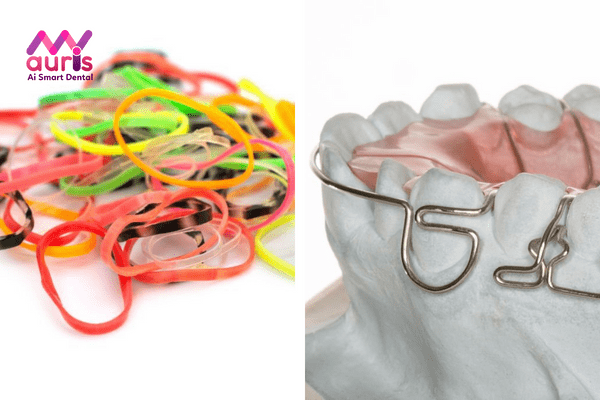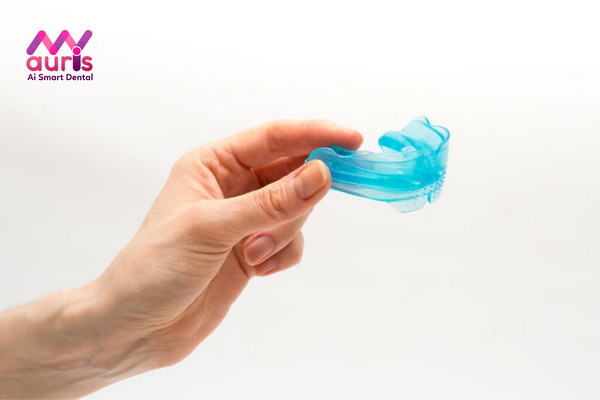According to the doctor’s assessment, braces are one of the cosmetic orthodontic solutions that can well overcome the shortcomings of buck teeth, buck teeth, underbites, and misalignments into beautiful, even teeth and a confident smile. To save maximum costs, many people have tried to do braces at home in many different ways. If you brace your teeth like that, will it have any effect? Please find out the information in the last article of My Auris dentistry!
Some ways to apply braces yourself at home
When you want to brace your teeth at home by using your hands or available tools to create orthodontic tools with the purpose of helping move teeth to the desired position on the jaw. This method is similar to orthodontics at clinics, the main purpose is to correct teeth defects such as protruding teeth, overbites, underbites, misaligned teeth, etc.
Here are some commonly used self-bracing methods:
Do-it-yourself braces by pushing teeth with your hands

Using hand force to push teeth is one of the quite simple home braces methods. You can apply this method to cases of slightly spaced or crooked teeth. Can be especially applied to young children aged 6 to 12 years old who are changing their teeth into permanent teeth.
Because at this time, the structure of the child’s teeth is not fully developed and is still quite soft. Using hand force to pull teeth together helps reduce the gap between teeth. In case of crooked teeth, you can combine scissors and tongue to push teeth outward to partly overcome tooth defects.
Bracing your own teeth with homemade tools
Currently, many people apply braces at home using homemade tools. Instead of using clear braces or trays, take advantage of available materials to make orthodontic tools right at home. Specifically:

- Use Using steel wire as braces: Thin steel wires are used to form orthodontic tools similar to the braces system at the dentist. Steel wires can create a gentle pulling force to straighten teeth to the desired position on the jaw.
- Use elastic bands to straighten teeth: In case you have gapped teeth, You can use elastic bands to perform braces. Because elastic bands have relatively good elasticity, they create a pulling force to help move teeth to the correct position. But in cases of severe gap teeth, applying elastic bands to braces will not bring the expected effect. Braces with braces
Currently, home braces are widely sold on the market, which are usually made from Silicon material and are mass-produced according to a certain mold. Braces are also often used for people aged 6 to 12 years old, when their permanent teeth are growing. far.

Braces at home with braces Methods applied to ensure teeth can grow in the right position, minimizing gaps in teeth, misaligned teeth, etc. However, as mentioned, these braces are often used. mass produced, so it will be difficult for you to choose the product that best suits your jaw.
In short, the above are all homemade braces and have not been tested for effectiveness by experts, so they may have potential complications that are dangerous to the user’s health. You should visit them directly See a doctor to be able to choose the appropriate treatment method.
Should you do braces yourself at home?
Should you do braces yourself at home? A common question of many customers, because according to the doctor, braces are a relatively complex dental method that requires the support of modern machines and doctors with a lot of expertise. Based on that, the doctor can create a treatment plan for each specific case.

Doctors answer: Should you arbitrarily brace your teeth at home? When you brace your teeth at home without a specific plan, only using homemade braces will not only bring poor orthodontic results but also pose potential risks to your health healthy.
- Causing pain and tooth sensitivity: The traction force from homemade tools cannot be evenly distributed, so it can cause long-term pain and sensitivity. It can even cause tooth enamel erosion because of direct friction over time long.
- Causes pulpitis: A quite dangerous complication when arbitrarily getting braces without consulting a specialist can create a sudden pulling force that causes the tooth to move suddenly and forcefully, leading to pulpitis and, more dangerously, death. pulp.
- Loose teeth: Teeth with root bridges are fixed on the jaw by periodontal tissue, so when performing orthodontics, moderate traction will help the teeth move slowly. When using homemade tools, the tooth roots will be subjected to great pressure. Over time, the tooth roots may become loose lay.
- Risk of dental diseases: Homemade tools will not be completely sterile. In addition, when you use them, these tools rub against tooth enamel and gum tissue, causing bacteria to multiply quickly in the oral cavity. In fact, there are many cases of bleeding gums and spontaneous periodontitis Braces at home.
- Misaligned bite: Not only does it put your teeth at risk of other diseases, but straightening your teeth can also cause a misaligned bite, especially for young children who are in the stage of growing permanent teeth bite misalignment.
Arranging your teeth at home is something that can cause many dangerous complications for the patient’s health. My Auris recommends that you visit a dentist with experience and expertise to get advice on a treatment regimen suitable for the condition you are suffering from as expected.
Yen Nhi





